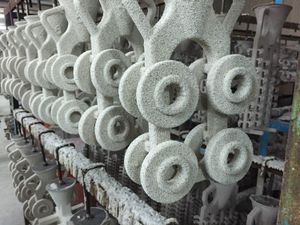It's Monday morning, and nothing is ready. Nevertheless! Let's go.
SCOPE CREEP.
- The Mediterranean fruit fly, or medfly, is a little brown fly that Wikipedia claims is "considered to be one of the most destructive fruit pests in the world." Medflies do live in Hawaii but not in the mainland US, and the USDA really wants to keep it that way; they say that "If the medfly were to become established in our country, consumer prices would go up and produce would become less available." The medfly is native to sub-Saharan Africa, but it's also present in southern Europe. Medflies plant their eggs inside fruit, including clementines (the little, easy-peeling mandarin oranges) which are imported to the US from, among other places, Spain — where medflies are known to live. So, the USDA issued a rule in 2002 that requires all Spanish clementines to be quarantined at 1.1–2.2 °C for 14 to 18 days — which is a fairly reliable way to kill them.
But! The cold quarantine isn't completely reliable, and it can result in damage to the fruit, so some agricultural researchers believe that X-ray radiation might prove advantageous: this study concludes that X-ray radiation is a "harmless and highly effective quarantine technique for clementine mandarin." This 2022 document shows that the USDA's Animal and Plant Health Inspection Service (APHIS) has certified six facilities to irradiate agricultural products, but two of them are in Hawaii and are used for domestic products only. - A rather gory rabbit-hole to go down: Calculating how much human blood the US exports.
- Humans don't hear air pressure. We hear oscillations in air pressure. When a compression wave ripples past us, our ears notice that the air pressure oscillates, the molecules of air pushing slightly harder against our eardrums at one moment, then pushing slightly less hard, over and over hundreds or thousands of times per second. This impresses me: Without thinking about it, my ears and brain do a bunch of math to figure out how quickly the air pressure is changing, and then render the result to me as a musical note. I'm pretty sure I don't have absolute pitch, but if you asked me to whistle middle C then I'd at least come within an octave of the correct note. Middle C — also called C4 — has a frequency of around 261 Hz. The C one octave lower (C3) is 130 Hz, and C5 is 525 Hz; this means that on command, I can produce oscillations in air pressure that are within 50% of the target frequency.
Humans generally can perceive oscillations that occur between twenty hertz and twenty kilohertz. But our sensitivity varies with frequency, our auditory systems being biased to the range between two and five kilohertz. You could test this for yourself by putting a pair of headphones on and plugging them into a sine tone generator. Keep sound pressure constant, but vary frequency, and you'll find that the tone sounds loudest between two and five kilohertz. Then, run it the other way: Try to adjust the sound pressure such that the tone seems to have the same volume, regardless of its pitch. Do this, and chart the results, and you'll have an equal-loudness contour: A roughly U-shaped graph showing how much sound pressure is required to produce constant perceived volume across a range of frequencies. - I read Maggie Smith's Dear Writer recently, and enjoyed it; I also enjoyed her poem "Good Bones," which you can read yourself here.
- Re: Kelly & Anna's recent writing on moving house, here's a collection of photos of an old Victorian being moved in San Francisco in 2020. I recommend clicking through; the dollies the house is supported by (seen here) are particularly cool.
- The new, official NYC Subway map is finally/once again an object of High Design.
- A sphere has constant positive curvature, which is determined by the sphere's radius: The larger the sphere, the smaller the curvature. Stand on the surface of the earth, and the curvature is so low it almost seems flat. But if you could zoom out, and squint a bit, you'd see the earth's as a more or less constant, convex surface.
A pseudosphere, on the other hand, has constant negative curvature. It's all concave, with a shape that looks a little like an ab wheel — a kind of exercise equipment I've witnessed in use but never dabbled in myself. - I'll be riding the Farmer's Daughter Gravel Grinder this Sunday; if you'll be there, say hi!

Teak is a kind of wood, Tectona grandis, native to Southeast Asia. In the US it is commonly used for deck and lawn furniture, which starts out reddish-brown and then silvers over time. Teak tends not to rot, and can remain in wet environments for long periods of time without experiencing much damage. There's a footbridge that crosses a lake in Myanmar that's made from teak. It is 1.2 kilometers long and was built in 1850, though the teak it was built out of is actually older, having been reclaimed from an old royal palace.
Like many other tropical hardwoods, the term "teak" is sometimes colloquially applied to species other than Tectona grandis. One of these is Dipteryx odorata, which is sometimes referred to as "Brazilian teak" but which is probably better known as cumaru. Cumaru trees produce seeds, called tonkin beans, which contain a chemical called coumarin. Coumarin is sometimes used in perfumes, and is apparently used to flavor some pipe tobaccos. Cumaru wood is, like true teak, mostly used for decking and lawn furniture.
Thanks as always to Scope of Work’s Members and Supporters for making this newsletter possible. Thanks also to Chris for helping source links this week.
Love, Spencer



